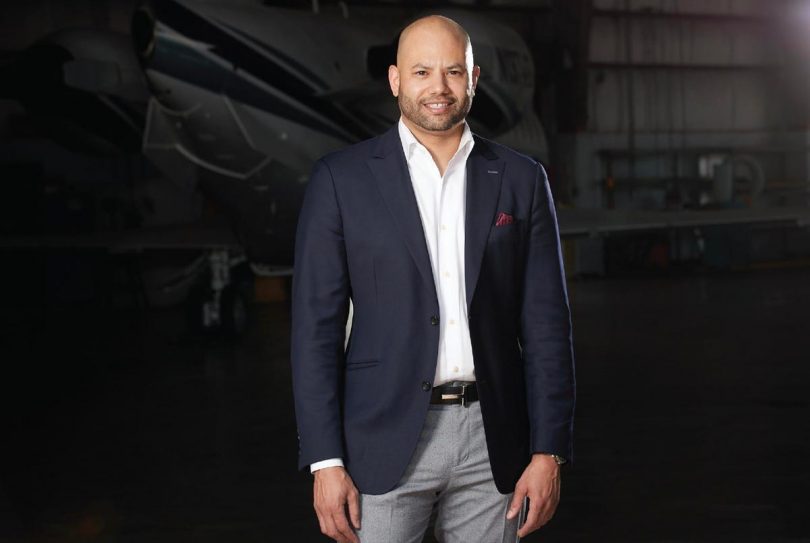Despite a record-setting number of private jet flights on the Sunday after Thanksgiving – over 13,000 according to Argus TraqPak, the system didn’t melt. While demand continues at record levels – WingX reports charter and fractional flights over the past month were 40% higher than the same period in 2019 – there have been no stories so far of flyers left stranded by their providers. That, in fact, was a fear of some in the industry.
Anthony Tivnan, president of Magellan Jets, says his company was helped by proactively encouraging clients to travel on alternate days. The Saturday and Monday after Turkey Day had volumes nearly equal to Sunday for the Boston-based broker.
COVID IMPACT: Magellan Jets President Anthony Tivnan says owners of some charter jets are turning … [+]
Going back to late Summer, several major jet card sellers, including Sentient Jet and Jet Linx Aviation, tried to slow demand by suspending sales to new members. Last month, Wheels Up announced new members who deposit $100,000 or less have to wait 90 days to fly. Magellan is telling new jet card customers they won’t be able to fly at fixed jet card rates until after the holidays.
NetJets, the largest operator of private jets globally, not only stopped card sales to new customers. It isn’t offering renewals for current members. They must join a waitlist that is now 1,500 names long and are being forced to look for new solutions as their hours run down.
At the same time, flyers who book charters on-demand, where flights are priced on a trip-by-trip basis, have seen those costs spike and selections become spartan.
Charter Flight Group CEO Jordan Brown says, “I’ve been doing this 20 years, and I always said, no matter what, I can get you a plane. It may cost you more, but I can get you a plane. That’s no longer true.”
Charter Flight Group launched a wholesale pricing jet card, including a fixed mark-up, so customers … [+]
He recently put the company’s fixed-rate jet card on hiatus, launching a new membership, which promises wholesale pricing with a markup ranging between 12%-18%.
“We were getting emails from (on-demand private charter) clients saying, ‘That’s triple what we were paying.’ The idea behind the wholesale pricing model is we want them to see the direct invoices from the charter companies, so they understand that’s where the market is. The management fee is our margin, so it’s transparent.”
The current state of the market underscores the value of having a good charter broker on speed dial. That’s because the way charter jets are sourced and booked, already prehistoric by Amazonian standards, has become even more complicated.
Here’s what’s happening, how it can impact your private charter requests, and what you can do to mitigate the turbulence.
“Water, water, everywhere. Nor any drop to drink,” goes the Rime of the Ancient Mariner. And it may seem that way when you see private jets parked wing-to-wing and tail-to-tail, like sardines in a can in places like Aspen and Los Cabos.
Owners of large cabin business jets no longer want shorter charter flights, trading them for more … [+]
Before the pandemic, private jets in the U.S. averaged less than one flight hour per day, according to JetNet. Operators of owned and fractional fleets considered 1,000 flight hours per year, less than three hours per day, to be high utilization. For smaller jets and turboprops, it was less. For example, during its Investors Day presentation, Wheels Up noted its King Air 350i fleet averaged just 30 flight hours per month.
That’s in part due to the complexity of operating airlines where customers set the schedule when they book, with jet cards, until recently, as few as 10 to 24 hours before departure.
“My boss was just at Teterboro (one of the busiest private jet airports), and he says there are hundreds of jets there. Why can’t he get a flight to Mexico next week,” one frustrated personal assistant recently asked me.
While there may still seem to be lots of jets sitting around, the rules of booking them have changed, say both brokers and operators.
The cost flying privately to the Caribbean and Mexico is increasing as jet owners want their planes … [+]
A large part of the U.S. charter fleet isn’t owned by the operators. They are managed for the owner of the aircraft, often a wealthy individual, who uses it for a mix of business and personal travel. The management company then charters the aircraft via independent brokers, direct to consumers, and to other operators with jet card programs needing lift beyond their own fleets. Ultimately, the owners of each aircraft decide when, to whom and for which flight requests their jets can be rented.
As a case in point, Tivnan says one specific jet his firm frequently charters and is based in Palm Beach is no longer available for repositioning flights. A benefit of flying privately is using more convenient airports. In the past, if you wanted to fly out of Boca Raton Airport, 25 miles to the south, it was no problem. The crew would fly it over, pick you up, and take you wherever you wanted to go.
Daniel Hirschorn, managing director of Luxury Aircraft Solutions and JetMembership.com (left) with … [+]
Now owners are concerned about shortages and increased costs of parts and getting required maintenance done in a timely matter. Essential maintenance is driven in part by cycles – landings and takeoffs. Each landing and takeoff puts more wear and tear on tires, land gear and engines, one more opportunity for something to break.
The owner, who has their flying needs to worry about, therefore doesn’t want those short hops. If they are even willing to quote the flight, what was a $1,200 repositioning fee is now $6,000.
“When they price it in that manner, the message is they don’t want the trip,” says Kevin Diemar, a former NetJets executive and CEO of Miami-based Unity Jets.
Instead of specifying an airport, brokers say let them know about your flexibility. Insisting on flying out of Morristown, a 30 minute drive to Teterboro, can decrease availability and increase price.
However, the beginning of December is proving even more challenging to source aircraft, says Daniel Hirschorn, managing director of Luxury Aircraft Solutions and JetMembership.com. He says owners, whose jets have been clocking extra hours since the demand surge started in June, are now taking them out of the charter market for scheduled maintenance They want them available during Christmas and through the January and February period. With the Super Bowl, NBA All-Star Game, the start of the PGA tour, and lots of folks heading to the slopes or the beaches, brokers and operators don’t see a slowdown anytime soon.
Another new reality is owners of large-cabin jets are turning down shorter flights, says Paramount Business Jets CEO Richard Zaher. If you are flying nine or more people, chances are you need a large cabin jet. In the past, that wasn’t an issue. There were plenty of lovely Gulfstream and Global Express jets available for hire.
“There’s just so much demand – owners have the flexibility to choose between the trips they want,” says Zaher. “Why take a two-hour trip with the same wear and tear when they know they will get a more lucrative five-hour flight a couple of hours later.”
Customers who need to fly on a specific day at a particular time from a specific airport may find themselves having to charter two light jets for their group.
Paramount, a pioneer in using wholesale dynamic pricing for jet cards, says that model is paying off. With flight costs up double digits, customers can see that the pricing reflects the current market, not fatter broker margins.
Diemar says getting hard quotes back from operators is also taking longer. Ferren Rajput, CEO of Denver-based OneFlight International, a broker, says owner approval in the past was mainly for larger aircraft. It is now often needed even for light jets. That means more time and phone calls. He’s doubled staff this year to keep up with the extra work and increased volume.
He’s also is in the process of buying several midsize aircraft to use for recovery flights for his jet card clients when an operator cancels their flight at the last minute. “When you go to recover (clients), it costs a ton of money,” he laments, adding, “For our own plane, we will be paying the direct operating costs.”
Many new private flyers don’t understand that when their flight is canceled by the operator, for a mechanical or any reason – unless they are in a membership program that provides replacement flights, they need to get a re-quote. In the past, those quotes were often not that much more than the original price since there was a surplus of supply. One veteran flyer recently told me a re-quote to Hawaii was $43,000 above his original price. Instead of Aloha dreams, he spent the day before departure calling to find an airplane.
Another change, Zaher says, is operators are becoming stricter in enforcing cancelation terms. One-way bookings on managed jets that operate from a base are often subject to a 100% cancelation penalty at the time of booking. Floating fleet operators have more lenient terms. However, there used to be wiggle room.
That’s because there was likely no lost opportunity cost if a customer canceled. The aircraft wasn’t likely to be chartered, anyway. Operators maintained goodwill with important brokers in a market where the was an oversupply of jets by offering refunds. Now, the owner of that jet likely lost other bookings.
Zaher says, at the beginning of the pandemic, when charter flights were down by 80%, if a client canceled because they had Covid or didn’t want to travel to a destination where there was an outbreak, operators were empathetic. Now, he says, expect to pay the cancelation penalty in your contract. For some users who never read contracts or are used to past practices, it’s an unpleasant surprise to lose $35,000.
What about those floating fleet operators that own jets or have blanket approval from owners? A large chunk is now under big players like Wheels Up, Vista Global, Directional, Fly Exclusive and Jet Edge. Each has its own jet card and membership programs and uses those airplanes to fulfill guarantees they make to customers who deposit hundreds of thousands of dollars.
Jet Edge, which bought Jet Select in January 2020 and launched its first jet card program this Spring, recently said it had taken over $100 million in deposits for customers who will want to use them flying on its fleet.
Wheels Up, which had a record $302 million of Q3 sales, snapped up four of the 10 largest charter operators in the last several years. It now has over 10,000 active members, many with contracts that guarantee availability to book charter flights on as little as 24 hours’ notice
Over the same period, Vista Global bought XOJet, Red Wing Aviation and Talon Air, three of the 16 largest U.S. charter operators. XOJet brought with it an off-fleet brokerage of over $100 million in charter demand. Vista then acquired Apollo Jets, a broker with $250 million in sales and jet sharing platform JetSmarter, which also had a book of around $65 million in full aircraft charter customers. It now has to source flights for those clients.
Directional, which used to supply the charter market when it sold aircraft being retired from Flexjet’s fractional fleet, is now keeping them for use by its in-house brokerages, Sentient Jet, FXAIR and PrivateFly. Sentient sold $450 million in jet cards with guaranteed access in 2020 and has around 8,000 members.
FlyExclusive and Jet Edge are buying up pre-owned aircraft, refurbishing them, and then using them to fly members of their jet card programs. In the past, some of those jets would have been in managed fleets, available to the general charter market.
Availability of aircraft for international flights is also an issue, says Tivnan. He says owners don’t want their airplanes sitting with a mechanical in Mexico or the Caribbean, where the time to get it repaired will likely take longer. They are also concerned their pilots could get stuck someplace if they test positive for Covid.
Rajput says when he books flights outside the Continental U.S., approval is now based on having the aircraft return immediately. In the past, owners were okay if their plane stayed for a long weekend or perhaps even a full week. Their pilots got a nice vacation paid for by the charter customer. Owners didn’t need the jet, and they weren’t going to get any other bookings during that brief period anyway. That’s changed. There are more trips to fly back home.
For consumers, it means they are now paying for two roundtrips, one when they go away and a second when they are coming home. If they aren’t in a jet card program with one-way pricing to international destinations, they are now paying double what they did in the past.
During a business aviation conference in Miami at the beginning of November, Fabian Bello, CEO of Journey Aviation, told attendees, “A GIV was priced the same for the last decade. It needs to be corrected.”
Diemar says charter rates that would see only low single-digit increases are now spiking 30% over what customers paid in the Spring. “We’re seeing six years of increases in six months,” he says.
When I relayed what I had been hearing to Andy Priester, Chairman of Chicago-based management company and charter operator Priester Aviation, which has been around since 1945, he said, “As a general statement, yes to all of the above.”
He adds, “Owners can be much more selective in the trips they want to do and still achieve the number of charter hours they want. They are making choices based on increased costs. They know another five-hour trip is going to come up the next day. If they think they need the airplane, they know they will make up revenue lost from trips they decline.”
After sharing the headlines from brokers with Dan Drohan, CEO of Petaluma, California-based Solairus Aviation, one of the largest managed-fleet charter operators in the country, he told me, “Your assessment is correct.”
He says across the industry owners and operators have less flexibility because they are “so backed up on the back ends with other trips.”
He adds, “For the first time in 25 plus years, I feel like we are getting away from a race to the bottom commoditized charter market.”
The boss of another operator said a large chunk of the flight price increases are not ending up in the pockets of owners. “They are paying their pilots more. Parts cost more. Because MROs are paying more to get workers to come back, maintenance costs are up. Ground handling fees are increasing. Fuel costs are up, so they are paying more for their own flights.” According to IATA, the price of jet fuel is up 50% from a year ago.
The executive said he’s not sympathetic to charter customers complaining about higher prices. “These guys have all made a ton of money in the stock market, in real estate, in Bitcoin. You look them up and see they just bought a $15 million 15th home, and then they have their assistants calling three brokers trying to negotiate $5,000 off a $100,000 trip. Sorry, that’s not how it works anymore.”
Despite booming sales and record demand, what’s not clear is how well financially the industry is doing. Despite a 55% jump in revenues during the past quarter, Wheels Up, the only big, publicly listed, pure play private charter company, saw losses increase as sales costs rose 65%.
One broker told me, “There’s a lot of money going around, but it’s not ending up with me.” He says any margin he makes selling on-demand charters goes to offsetting losses he is taking from buying flights for jet card clients with rate guarantees, higher salaries for staff, and adding operations employees to keep up with increased work it takes to source aircraft and find replacements when there are cancelations.
If you aren’t in a program that offers fixed or capped rates, brokers recommend being flexible. Moving your trip by a day or two – not always possible – can make a big difference.
So can being open to alternative destinations. Diemar notes, charter prices from New York to the Caribbean this Winter are up as much as 50% compared to last year, while flight costs within the contiguous 48 states are 25%-to-30% higher. If you are watching your budget, that means you can fly eight people on a super midsize jet to Scottsdale, Tucson or San Diego for prices similar to what you would have paid last year to go the Caribbean.
The best advice from brokers is to book as far in advance as possible. Charter Flight Group’s Brown says think 60 to 90 days ahead. Another imperative is to read the contract. Make sure you understand what happens when you cancel, and what happens if the provider cancels your flight.
Understand the extra charges, from deicing to WiFi, which can add up into multiple thousands of dollars and will hit your credit card on file weeks to months after you are back home. Make sure you understand what you can’t do, like showing up an hour late with pets and passengers not already on the manifest, or bringing excessive luggage.
That said, if you have a good broker, he or she will explain all of the pitfalls to you and help navigate you away from them. It’s something that’s best done over the phone or in person if you live near your broker. That’s not for your provider’s sake, who may find it less time consuming to just act on text messages.
For customers who take the time to have a relationship with their broker instead of just grinding them, they gain the benefit of their broker’s knowledge and expertise, which these days, if not like gold, is certainly like Bitcoin.








